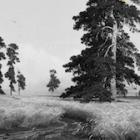Hayes, Jack Patrick. “Modernisation with Local Characteristics: Development Efforts and the Environment on the Zoige Grass and Wetlands, 1949-2005.” Environment and History 16, no. 3 (August 2010): 323–47. doi:10.3197/096734010X519780. Republished by the Environment & Society Portal, Multimedia Library. http://www.environmentandsociety.org/node/7608.
The Zoige grasslands (Chinese, Ruo’er gai) on the eastern edge of the Tibetan Plateau are a wetland and grassland region composed of marshes, bogs, wet meadows and shallow lakes interspersed with low hills and sub-alpine meadows. These grass and wetlands are recognised as an important grazing zone for western China, a globally significant biodiversity hotspot and major bird flyway. Since the late 1980s, research on the region has highlighted increasing regional environmental degradation. This study is an overview of the state-led development projects and local efforts to ‘improve’ local conditions on the grass and wetlands since 1949 and their impact on the regional ecological and social environment. It focuses mainly on historical state-led development projects to study and alter the wetlands, as well as more recent efforts to raise environmental awareness of the importance of Chinese wetlands. Development efforts by the Chinese state have led to both positive and negative outcomes for local Tibetan residents who had little or no say in modernisation efforts until the late 1980s, but who have received most of the blame for regional environmental problems. Despite recognised problems with water use and wetland degradation, as well as administrative emphasis on fencing, settlement and official land use management in nature reserves, the Chinese state continues to dominate discourse and management of the Zoige wetlands. However, local Tibetans have played an increasing role in regional wetland management. A historical assessment, in contrast to media portrayals and official discourses of the origins of grass and wetland degradation, explains more about the processes of degradation, and with increased local participation, points a new way forward to help in the formulation of more effective policies and mitigation measures.
— Text from The White Horse Press website
All rights reserved. © 2010 The White Horse Press


